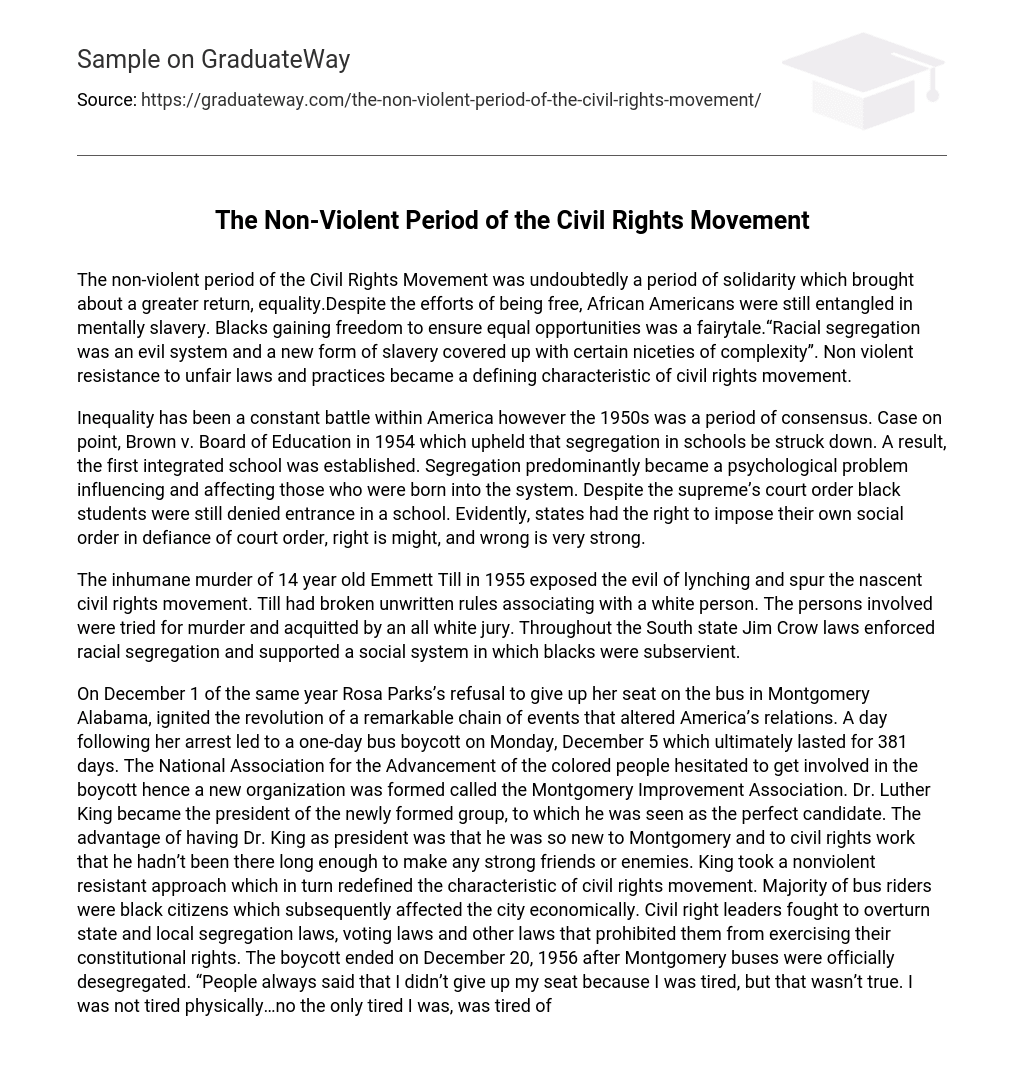The non-violent period of the Civil Rights Movement was undoubtedly a period of solidarity which brought about a greater return, equality.Despite the efforts of being free, African Americans were still entangled in mentally slavery. Blacks gaining freedom to ensure equal opportunities was a fairytale.“Racial segregation was an evil system and a new form of slavery covered up with certain niceties of complexity”. Non violent resistance to unfair laws and practices became a defining characteristic of civil rights movement.
Inequality has been a constant battle within America however the 1950s was a period of consensus. Case on point, Brown v. Board of Education in 1954 which upheld that segregation in schools be struck down. A result, the first integrated school was established. Segregation predominantly became a psychological problem influencing and affecting those who were born into the system. Despite the supreme’s court order black students were still denied entrance in a school. Evidently, states had the right to impose their own social order in defiance of court order, right is might, and wrong is very strong.
The inhumane murder of 14 year old Emmett Till in 1955 exposed the evil of lynching and spur the nascent civil rights movement. Till had broken unwritten rules associating with a white person. The persons involved were tried for murder and acquitted by an all white jury. Throughout the South state Jim Crow laws enforced racial segregation and supported a social system in which blacks were subservient.
On December 1 of the same year Rosa Parks’s refusal to give up her seat on the bus in Montgomery Alabama, ignited the revolution of a remarkable chain of events that altered America’s relations. A day following her arrest led to a one-day bus boycott on Monday, December 5 which ultimately lasted for 381 days. The National Association for the Advancement of the colored people hesitated to get involved in the boycott hence a new organization was formed called the Montgomery Improvement Association. Dr. Luther King became the president of the newly formed group, to which he was seen as the perfect candidate. The advantage of having Dr. King as president was that he was so new to Montgomery and to civil rights work that he hadn’t been there long enough to make any strong friends or enemies. King took a nonviolent resistant approach which in turn redefined the characteristic of civil rights movement. Majority of bus riders were black citizens which subsequently affected the city economically. Civil right leaders fought to overturn state and local segregation laws, voting laws and other laws that prohibited them from exercising their constitutional rights. The boycott ended on December 20, 1956 after Montgomery buses were officially desegregated. “People always said that I didn’t give up my seat because I was tired, but that wasn’t true. I was not tired physically…no the only tired I was, was tired of giving in. Parks became the mother of civil rights movement.
Following the 1954 Supreme Court ruiling in Bown v. Board of Education, governments in the South looked for loopholes to keep segregation intact. Correspondingly in 1957 nine African American students known as Little Rock Nine arrived at the Central High School. Instead, they were offered protection by the police against angry citizens who opposed the integration.
It is also important to note that even though all Americans had gained the right to vote, many southern states made it difficult for blacks to exercise their franchise. They often required them to take voter literacy tests that were confusing, misleading and nearly impossible to pass. Such practices necessitated the Civil Rights Act of September 1957 which President Dwight Eisenhower signed into laws. These laws allowed persons to be prosecuted for infringing on the basic rights of the black citizens. Civil rights movement was making huge strides in the South, African American separatists and militants were gaining a foothold in impoverished African neighborhoods in the North. Replace the call for non-violence with self defense and revolution, integration with black separatism and autonomy. Needless to say persons were still somewhat timid to demand their rights though they were entrenched in the constitution. This was in the case of the four college students from Greensboro who started a revolution by sitting down. The students targeted Woolworth’s store in North Carolina on February 1, 1960 which allowed black customers to shop but not to eat at the lunch counter. Such act did not sit well with the four, so they sat in the shop until closing. This became a constant practice and as a result the movement started. They did what was necessary to tolerate segregation, but they’d have enough. Eventually protestors launched a boycott of all segregated lunch counters in Greensboro. As sales dropped precipitously, Woolworth’s stores and other businesses abandoned the segregation policies. The site of the first Woolworth’s sit-in is the current location of The International Civil Rights Center & Museum in Greensboro, North Carolina. Most of the lunch counter seats are still in it. Evidently, others were influenced and the movement started to spread globally.
Among the group of Civil Rights fighters was the Congress of Racial Equality founded in 1942. Civil Rights group was the Congress of Racial Equality (CORE), founded in 1942. This group along with the Student Non-Violent Coordination Committee (SNCC)- a youth arm of the Civil Rights Movements – were chiefly responsible for the freedom rides of 1961. Freedom riders was an attempt to break the segregation laws on interstate transportations. A group of seven riders on a Greyhound bus on Mother’s Day 1961 travelled from Atlanta, Georgia to Anniston, Alabama. An angry crowd of segregationists waylaid the bus there and immediately attacked it slashing tires, hurling stones, smashed windows with their fists and banged the sides. Government intervention took place and rectified the issue. These early victories encouraged more African Americans movements.





